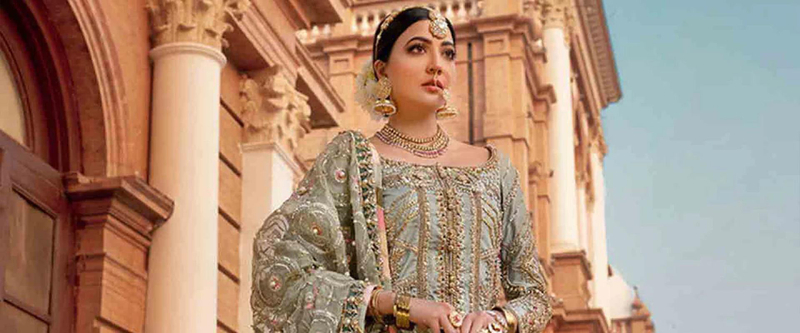Embroidery holds immense cultural and aesthetic significance in Pakistani salwar suits, often reflecting the heritage, craftsmanship, and regional identity. Traditional styles, such as zardozi (golden thread embroidery) and phulkari (flower-like patterns), symbolize the rich history of artisan communities from different parts of Pakistan. Each stitch, whether it is delicate threadwork or elaborate mirror embellishments, tells a story of cultural pride and artistic mastery. These embroideries are not only a visual spectacle but also serve as an indication of social status, with intricate designs typically featured in special occasion wear, like weddings and festive events. In modern times, embroidery continues to play a vital role in enhancing the aesthetic appeal of Pakistani Latest Wedding Dresses, merging traditional motifs with contemporary touches. This evolution allows Pakistani embroidery to maintain its relevance while appealing to modern fashion trends, keeping the artistry alive and ensuring that it remains an essential part of the cultural and fashion landscape.
A Rich Tradition of Embroidery in Pakistan
The rich tradition of embroidery in Pakistan dates back centuries, with distinct regional styles that have evolved over time. Some of the most renowned forms include zardozi, a type of gold thread embroidery, and phulkari, a floral motif-based technique native to Punjab. These craft traditions not only highlight the country’s artistic heritage but also carry social significance. Detailed, hand-stitched patterns were often seen in the attire of royalty and nobility, symbolizing wealth and status. Additionally, kantha and Chikankari are other popular embroidery techniques, each associated with specific regions and ethnic communities. As fashion trends have evolved, these traditional forms of embroidery have been fused with contemporary designs to create modern salwar suits, making the timeless art forms accessible to a broader audience, both locally and globally. These embroidered salwar suits continue to represent cultural pride and craftsmanship, bridging the past with the present.
The Role of Embroidery in Pakistani Salwar Suits
Embroidery plays a central role in the design and cultural significance of Pakistani salwar suits, elevating their aesthetic appeal and deepening their connection to tradition. It has a symbolic and practical function, enhancing the texture and color of the garment while representing the skills of regional artisans. Some of the most admired embroidery techniques include zardozi, which uses metallic threads to create intricate patterns, and phulkari, with its vibrant floral motifs often seen in Punjab.
The kantha stitch, traditionally used in Bengali embroidery, and Chikankari, primarily found in Lucknow, are also popular additions to Pakistani salwar suits. These delicate, detailed forms of embroidery transform a simple salwar suit into a statement piece, making it suitable for special occasions such as weddings, festivals, and other social gatherings. In the contemporary fashion scene, embroidery has evolved to blend traditional techniques with modern elements, allowing the salwar suit to remain relevant while honouring its heritage.
Types of Embroidery Techniques in Pakistani Summer Suits
Pakistani summer suits, known for their light fabrics and breathable designs, are often adorned with intricate embroidery techniques that enhance their charm. Some of the most popular embroidery types used in these suits include:
- Chakan Kari: Originating from Lucknow, this style features fine threadwork creating delicate floral patterns. It is especially popular in hot weather as the lightweight fabric and detailed, airy stitchwork ensure comfort and elegance.
- Zardozi: This luxurious gold or silver thread embroidery technique is typically used on more formal or festive summer suits. Zardozi adds a regal touch and is often found on evening or wedding wear.
- Phulkari: Known for its vivid, geometrically inspired flower patterns, phulkari embroidery is commonly seen in Punjabi styles. The colourful designs are both light and airy, making them perfect for summer occasions.
- Aari Work: This fine chain stitch embroidery is used for creating intricate designs and borders, often highlighting floral and abstract patterns in both bright and subtle hues. Aari work suits lighter summer materials like cotton or chiffon.
These embroidery techniques add depth and texture to Pakistani summer suits for ladies while celebrating the country's rich craftsmanship and cultural heritage, making them ideal for warmer seasons without sacrificing style.
The Cultural Significance of Embroidery
Embroidery in Pakistani fashion carries profound cultural significance, representing not just a form of artistic expression, but also a link to the country’s rich heritage and regional identities. Each embroidery technique, from zardozi and phulkari to Chikankari and kantha, reflects the traditions of ethnic communities and regions. For example, phulkari, with its vibrant floral patterns, is often seen in Punjabi wedding attire, symbolizing prosperity, and happiness. Similarly, zardozi, using metallic threads, was historically used in royal attire, representing luxury and status. Embroidery also carries social and emotional meaning.
In some regions, the hand-stitched designs are passed down through generations, preserving familial ties and local craftsmanship. In the modern fashion scene, these traditional forms have been innovatively combined with contemporary styles, enabling younger generations to connect with their cultural roots while staying fashionable. Thus, embroidery is more than just decoration in Pakistani clothing; it is a means of preserving cultural stories, expressing social identity, and fostering a sense of pride in artistic traditions.
Pakistani Embroidery and Global Fashion
Pakistani embroidery has made a significant impact on global fashion, attracting attention for its intricate designs, fine craftsmanship, and rich cultural heritage. Traditional techniques like zardozi, phulkari, and Chikankari have crossed cultural boundaries, appearing on runways and collections from high-end designers worldwide. These embroidery styles are celebrated not only for their beauty but for their deep symbolism and craftsmanship, showcasing regions’ unique histories and cultures. For instance, zardozi, with its opulent metallic threadwork, has been featured in luxury collections, blending traditional Eastern aesthetics with Western couture.
Meanwhile, phulkari’s colourful motifs evoke cultural narratives of joy and prosperity, often used in contemporary fashion to bring ethnic elegance to modern wear. The growing demand for embroidered garments has opened global markets for Pakistani artisans, especially in countries where consumers seek to incorporate diverse cultural elements into their fashion. This blending of Pakistani embroidery with global fashion underscores how traditional artistry can be both preserved and celebrated on an international stage. The global appeal of these techniques also drives interest in the skills of local artisans, providing an economic boost and promoting cross-cultural exchange.


